What Polarimetric Weather Radars Offer to Cloud Modelers: Forward Radar Operators and Microphysical/Thermodynamic Retrievals
Abstract
1. Introduction
2. Electromagnetic Model of Scattering and Forward Operators
2.1. Scattering by Individual Hydrometeor
2.2. Polarimetric Radar Forward Operators
2.3. Utilization of the Forward Operators with Bulk and Spectral Bin Models
2.3.1. Spectral Bin Models
2.3.2. Bulk Models
3. Microphysical Retrievals
3.1. Radar Microphysical Retrievals in Rain
3.2. Radar Microphysical Retrievals in Ice and Snow
3.3. Illustration of the Polarimetric Microphysical Retrievals for Hurricane Harvey
4. Thermodynamic Retrievals
5. Conclusions
Author Contributions
Funding
Acknowledgments
Conflicts of Interest
Appendix A
References
- Bringi, V.; Chandrasekar, V. Polarimetric Doppler Weather Radar. Principles and Applications; Cambridge University Press: Cambridge, UK, 2001; p. 634. [Google Scholar]
- Zhang, G. Weather Radar Polarimetry; CRC Press: Boca Raton, FL, USA, 2016; p. 304. [Google Scholar]
- Ryzhkov, A.; Zrnic, D. Radar Polarimetry for Weather Observations; Springer Atmospheric Sciences: Cham, Switzerland, 2019; p. 486. [Google Scholar]
- Morrison, H.; Milbrandt, J.; Bryan, G.; Ikeda, S.; Tessendorf, S.; Thompson, G. Parameterization of Cloud Microphysics Based on the Prediction of Bulk Ice Particle Properties. Part II: Case Study Comparisons with Observations and Other Schemes. J. Atmos. Sci. 2015, 72, 312–339. [Google Scholar] [CrossRef]
- Fan, J.; Han, B.; Varble, A.; Morrison, H.; North, K.; Kollias, P.; Chen, B.; Dong, X.; Giangrande, S.E.; Khain, A.; et al. Cloud-resolving model intercomparisons of an MC3E squall line case: Part I—Convective updrafts. J. Geophys. Res. Atmos. 2017, 122, 9351–9378. [Google Scholar] [CrossRef]
- Melnikov, V.; Zrnic, D.; Doviak, R.; Chilson, P.; Mechem, D.; Kogan, Y. Prospects of the WSR-88D radar for cloud studies. J. Appl. Meteorol. Climtol. 2011, 50, 859–872. [Google Scholar] [CrossRef]
- Zhang, G.; Mahale, V.N.; Putnam, B.J.; Qi, Y.; Cao, Q.; Byrd, A.D.; Bukovcic, P.; Zrnic, D.S.; Gao, J.; Xue, M.; et al. Current status and future challenges of weather radar polarimetry: Bridging the gap between radar meteorology/hydrology/engineering and numerical weather prediction. Adv. Atmos. Sci. 2019, 36, 571–588. [Google Scholar] [CrossRef]
- Holt, A. Some factors affecting the remote sensing of rain by polarization diversity radar in the 3- to 35-GHz frequency range. Radio Sci. 1984, 19, 1399–1412. [Google Scholar] [CrossRef]
- Ryzhkov, A. Interpretation of polarimetric radar covariance matrix for meteorological scatterers. Theoretical analysis. J. Atmos. Ocean. Technol. 2001, 18, 315–328. [Google Scholar] [CrossRef]
- Holt, A.; Shepherd, J. Electromagnetic scattering by dielectric spheroids in the forward and backward directions. J. Phys. A Math. General 1979, 12, 159–166. [Google Scholar] [CrossRef]
- Vivekanandan, J.; Adams, W.; Bringi, V. Rigorous approach to polarimetric radar modeling of hydrometeor orientation distributions. J. Appl. Meteorol. 1991, 30, 1053–1063. [Google Scholar] [CrossRef]
- Van de Hulst, H. Light Scattering by Small Particles; Dover: New York, NY, USA, 1981; p. 536. [Google Scholar]
- Maxwell Garnett, J. Color in metal glasses and in metallic films. Philos. Trans. R. Soc. Lond. A 1904, 203, 385–420. [Google Scholar]
- Bohren, C.; Huffman, D. Absorption and Scattering of Light by Small Particles; Wiley: Hoboken, NJ, USA, 1983; p. 530. [Google Scholar]
- Ryzhkov, A.; Pinsky, M.; Pokrovsky, A.; Khain, A. Polarimetric radar observation operator for a cloud model with spectral microphysics. J. Appl. Meteorol. Climatol. 2011, 50, 873–894. [Google Scholar] [CrossRef]
- Waterman, P. Matrix formulation of electromagnetic scattering. Proc. IEEE 1965, 53, 805–812. [Google Scholar] [CrossRef]
- Barber, P.; Yeh, C. Scattering of electromagnetic waves by arbitrary shaped dielectric bodies. Appl. Opt. 1975, 14, 2684–2872. [Google Scholar] [CrossRef] [PubMed]
- Mishchenko, M. Calculation of the amplitude matrix for a nonspherical particle in a fixed orientation. Appl. Opt. 2000, 39, 1026–1031. [Google Scholar] [CrossRef] [PubMed]
- Bringi, V.; Seliga, T. Scattering from axisymmetric dielectrics or perfect conductors imbedded in an axisymmetric dielectric. IEEE Trans. Antennas Prop. 1977, 25, 575–580. [Google Scholar] [CrossRef]
- Aydin, K.; Zhao, Y. A computational study of polarimetric radar observables in hail. IEEE Trans. Geosci. Remote Sens. 1990, 28, 412–422. [Google Scholar] [CrossRef]
- Depue, T.; Kennedy, P.; Rutledge, S. Performance of the hail differential reflectivity (HDR) polarimetric hail indicator. J. Appl. Meteorol. Climatol. 2007, 46, 1290–1301. [Google Scholar] [CrossRef]
- Ryzhkov, A.; Kumjian, M.; Ganson, S.; Khain, A. Polarimetric radar characteristics of melting hail. Pt I: Theoretical simulations using spectral microphysical modeling. J. Appl. Meteorol. Climatol. 2013, 52, 2849–2870. [Google Scholar] [CrossRef]
- Lu, Y.; Clothiaux, E.; Aydin, K.; Botta, G.; Verlinde, J. Modeling variability in dendritic ice crystal backscattering cross sections at millimeter wavelengths using a modified Rayleigh-Gans theory. J. Quant. Spectros. Radiat. Transfer 2013, 131, 95–104. [Google Scholar] [CrossRef]
- Aydin, K.; Seliga, T. Radar polarimetric backscattering properties of conical graupel. J. Atmos. Sci. 1984, 41, 1887–1892. [Google Scholar] [CrossRef][Green Version]
- Waterman, P. Scattering by dielectric obstacles. Alta Freq. 1969, 38, 348–352. [Google Scholar]
- Lu, Y.; Jiang, Z.; Aydin, K.; Verlinde, J.; Clothiaux, E.; Botta, G. A polarimetric scattering database for non-spherical ice particles at microwave wavelengths. Atmos. Meas. Tech. 2016, 9, 5119–5134. [Google Scholar] [CrossRef]
- Xu, Y. Electromagnetic scattering by an aggregate of spheres. Appl. Opt. 1995, 34, 4573–4588. [Google Scholar] [CrossRef] [PubMed]
- Yurkin, M.; Hoekstra, A. The discrete-dipole approximation code ADDA: Capabilities and known limitations. J. Quant. Spectros. Radiat. Transfer. 2011, 112, 2234–2247. [Google Scholar] [CrossRef]
- Mirkovic, D. Computational Electromagnetics for Polarimetric Radar Scatterers: An Approach to Polarimetric Variable Modeling of Hydrometeors and Biota; Lambert Academic Publishing: Saarbrucken, Germany, 2016; p. 272. [Google Scholar]
- Harrington, R. Field Computation by Moment Methods; IEEE PRESS Series on Electromagnetic Waves: Piscataway, NJ, USA, 1993; p. 228. [Google Scholar]
- WIPL-D. WIPL-D Pro EM Solver. (WIPL-D d.o.o). 2019. Available online: www.wipl-d.com (accessed on 15 January 2020).
- Botta, G.; Aydin, K.; Verlinde, J. Modeling of microwave scattering from cloud ice crystal aggregates and melting aggregates: A new approach. IEEE Geosci. Remote Sens. Lett. 2010, 7, 572–576. [Google Scholar] [CrossRef]
- Tyynela, J.; Leinonen, J.; Moisseev, D.; Nousiainen, T. Radar backscattering from snowflakes: Compariosn of fractal, aggregate, and soft spheroid models. J. Atmos. Ocean. Technol. 2011, 28, 1365–1372. [Google Scholar] [CrossRef]
- Leinonen, J.; Kneifel, S.; Moisseev, D.; Tyynela, J.; Tanelli, S.; Nousianen, T. Evidence of nonspheroidal behavior in millimeter-wavelength radar observations of snowfall. J. Geophys. Res. 2012, 117, D18205. [Google Scholar] [CrossRef]
- Tyynela, J.; Chandrasekar, V. 2014: Characterizing falling snow using multifrequency dual-polarization measurements. J. Geophys. Res. Atmos. 2014, 119, 8268–8283. [Google Scholar]
- Ori, D.; Maestri, T.; Rizzi, R.; Montopoli, M.; Marzano, F. Scattering properties of modeled complex snowflakes and mixed-phase particles at microwave and millimeter frequencies. J. Geophys. Res. Atmos. 2014, 119, 9931–9947. [Google Scholar] [CrossRef]
- Leinonen, J.; Moisseev, D. What do triple-frequency radar signatures reveal about aggregate snowflakes? J. Geophys. Res. Atmos. 2015, 120, 229–239. [Google Scholar] [CrossRef]
- Schrom, R.; Kumjian, M. Bulk-density representations of branched planar ice crystals: Errors in the polarimetric radar variables. J. Appl. Meteorol. Climatol. 2018, 57, 333–346. [Google Scholar] [CrossRef]
- Fabry, F.; Szyrmer, W. Modeling of the melting layer. Part II: Electromagnetic. J. Atmos. Sci. 1999, 56, 3593–3600. [Google Scholar] [CrossRef]
- Chobanyan, E.; Sekeljic, N.; Ilic, M.; Bringi, V.; Notaros, B. Efficient and accurate computational electromagnetics approach to precipitation particle scattering analysis based on higher-order method of moments integral equation modeling. J. Atmos. Ocean. Technol. 2015, 32, 1745–1758. [Google Scholar] [CrossRef]
- Milbrand, J.; Yau, M. A multimoment bulk microphysical parameterization. Part II: A proposed three-moment closure and scheme description. J. Atmos. Sci. 2005, 62, 3065–3081. [Google Scholar] [CrossRef]
- Harrington, J.; Sulia, K.; Morrison, H. A method for adaptive habit prediction in bulk microphysical models. Part I: Theoretical development. J. Atmos. Sci. 2013, 70, 349–364. [Google Scholar]
- Sulia, K.; Kumjian, M. Simulated polarimetric fields of ice vapor growth using the Adaptive Habit Model. Part I: Large-Eddy Simulations. Mon. Weather Rev. 2017, 145, 2281–2302. [Google Scholar] [CrossRef]
- Sulia, K.; Kumjian, M. Simulated polarimetric fields of ice vapor growth using the Adaptive Habit Model. Part II: A case study from the FROST experiment. Mon. Weather Rev. 2017, 145, 2303–2323. [Google Scholar] [CrossRef]
- Li, H.; Moisseev, D.; von Lerber, A. How does riming affect dual-polarization radar observations and snowflake shape? J. Geophys. Res. Atmos. 2018, 123, 6070–6081. [Google Scholar] [CrossRef]
- Matrosov, S.; Reinking, R.; Kropfli, R.; Bartram, B. Estimation of ice hydrometeor types and shapes from radar polarization measurements. J. Atmos. Ocean. Technol. 1996, 13, 85–96. [Google Scholar] [CrossRef][Green Version]
- Straka, J.; Zrnic, D.; Ryzhkov, A. Bulk hydrometeor classification and quantification using multiparameter radar data. Synthesis of relations. J. Appl. Meteorol. 2000, 39, 1341–1372. [Google Scholar] [CrossRef]
- Korolev, A.; Isaac, G. Roundness and aspect ratio of particles in ice clouds. J. Atmos. Sci. 2003, 60, 1795–1808. [Google Scholar] [CrossRef]
- Matrosov, S.; Schmitt, C.; Maahn, M.; de Boer, G. Atmospheric ice particle shape estimates from polarimetric radar measurements and in situ observations. J. Atmos. Ocean. Technol. 2017, 34, 2569–2587. [Google Scholar] [CrossRef]
- Matrosov, S. Ice hydrometeor shape estimations using polarimetric operational and research radar measurements. Atmosphere 2020, 11, 97. [Google Scholar] [CrossRef]
- Jung, Y.; Zhang, G.; Xue, M. Assimilation of simulated polarimetric radar data for a convective storm using the Ensemble Kalman Filter. Part I: Observation operators for reflectivity and polarimetric variables. Mon. Weather Rev. 2008, 136, 2228–2245. [Google Scholar] [CrossRef]
- Brandes, E.; Zhang, G.; Vivekanandan, J. Experiments in rainfall estimation with polarimetric radar in a subtropical environment. J. Appl. Meteorol. 2002, 41, 674–685. [Google Scholar] [CrossRef]
- Melnikov, V.; Straka, J. Axis ratios and flutter angles of cloud ice particles: Retrievals from radar data. J. Atmos. Ocean. Technol. 2013, 30, 1691–1703. [Google Scholar] [CrossRef]
- Ryzhkov, A.; Bukovcic, P.; Murphy, A.; Zhang, P.; McFarquhar, G. Ice Microphysical Retrievals Using Polarimetric Radar Data. In Proceedings of the 10th European Conference on Radar in Meteorology and Hydrology, Ede, The Netherlands, 1–6 July 2018. [Google Scholar]
- Ray, P. Broadband complex refractive indices of ice and water. Appl. Opt. 1972, 11, 1836–1844. [Google Scholar] [CrossRef]
- Ryzhkov, A. The impact of beam broadening on the quality of radar polarimetric data. J. Atmos. Ocean. Technol. 2007, 24, 729–744. [Google Scholar] [CrossRef]
- Ryzhkov, A.; Zrnic, D. Depolarization in ice crystals and its effect on radar polarimetric measurements. J. Atmos. Ocean. Technol. 2007, 24, 1256–1267. [Google Scholar] [CrossRef]
- Hubbert, J.; Ellis, S.; Chang, W.-Y.; Rutledge, S.; Dixon, M. Modeling and interpretation of S-band ice crystals depolarization signatures from data obtained by simultaneously transmitting horizontally and vertically polarized fields. J. Appl. Meteorol. Climatol. 2014, 53, 1659–1676. [Google Scholar] [CrossRef]
- Pfeifer, M.; Craig, G.; Hagen, M.; Keil, C. A polarimetric radar forward operator for model evaluation. J. Appl. Meteorol. Climatol. 2008, 47, 3203–3220. [Google Scholar] [CrossRef]
- Baldauf, M.; Seifert, A.; Forstner, J.; Majewski, D.; Raschendorfer, M.; Reinhardt, T. Operational convective-scale numerical weather prediction with the COSMO Model: Description and sensitivities. Mon. Weather Rev. 2011, 139, 3887–3905. [Google Scholar] [CrossRef]
- Andsager, K.; Beard, K.; Laird, N. Laboratory measurements of axis ratios for large drops. J. Atmos. Sci. 1999, 56, 2673–2683. [Google Scholar] [CrossRef]
- Ryzhkov, A.; Zrnic, D.; Hubbert, J.; Bringi, V.; Vivekanandan, J.; Brandes, E. Polarimetric radar observations and interpretation of co-cross-polar correlation coefficients. J. Atmos. Ocean. Technol. 2002, 19, 340–354. [Google Scholar] [CrossRef][Green Version]
- Xue, M.; Wang, D.; Gao, J.; Brewster, K.; Droegemeier, K. The Advanced Regional Prediction System (ARPS), storm-scale numerical weather prediction and data assimilation. Meteorol. Atmos. Phys. 2003, 82, 139–170. [Google Scholar] [CrossRef]
- Dawson, D.; Mansell, E.; Jung, Y.; Wicker, L.; Kumjian, M.; Xue, M. Low-level ZDR signatures in supercell forward flanks: The role of size sorting and melting of hail. J. Atmos. Sci. 2014, 71, 276–299. [Google Scholar] [CrossRef]
- Snyder, J.; Bluestein, H.; Dawson, D.; Jung, Y. Simulations of polarimetric, X-band radar signatures in supercells. Part I: Description of experiment and simulated ρhv rings. J. Appl. Meteorol. Climatol. 2017, 56, 1977–1999. [Google Scholar] [CrossRef]
- Snyder, J.; Bluestein, H.; Dawson, D.; Jung, Y. Simulations of polarimetric, X-band radar signatures in supercells. Part II: ZDR columns and rings and KDP columns. J. Appl. Meteorol. Climatol. 2017, 56, 2001–2026. [Google Scholar] [CrossRef]
- Khain, A.; Pinsky, M. Physical Processes in Clouds and Cloud Modeling; Cambridge University Press: Cambridge, UK, 2018; p. 686. [Google Scholar]
- Augros, C.; Caumont, O.; Ducrocq, V.; Gaussiat, N.; Tabary, P. Comparisons between S-, C-, and X-band polarimetric radar observations and convective-scale simulations of the HyMex first special observing period. Q. J. R. Meteorol. Soc. 2016, 142, 347–362. [Google Scholar] [CrossRef]
- Wolfensberger, D.; Berne, A. From model to radar variables: A new forward polarimetric radar operator for COSMO. Atmos. Meas. Tech. 2018, 11, 3883–3916. [Google Scholar] [CrossRef]
- Matsui, T.; Dolan, B.; Rutledge, S.; Tao, W.-K.; Iguchi, T.; Barnum, J.; Lang, S. POLARRIS: A POLArimetric Radar Retrieval and Instrument Simulator. J. Geophys. Res. Atmos. 2019, 124, 4634–4657. [Google Scholar] [CrossRef]
- Mendrok, J.; Snyder, J.; Troemel, S.; Blahak, U. Towards an Efficient Radar Forward Operator for NWP Frameworks. In Proceedings of the 39th Conference on Radar Meteorology, Nara, Japan, 16–20 September 2019. [Google Scholar]
- Oue, M.; Kollias, P.; Tatarevic, A.; Wang, D.; Yu, K. The Cloud Resolving Model Radar Simulator (CR-SIM) Version 3.3. 2019. Available online: https://commons.library.stonybrook.edu/somasdata/4 (accessed on 15 January 2020).
- Lafore, J.P.; Stein, J.; Asencio, N.; Bougeault, P.; Ducrocq, V.; Duron, J.; Fischer, C.; Héreil, P.; Mascart, P.; Masson, V.; et al. The Meso-NH Atmospheric Simulation System. Part I: Adiabatic formulation and control simulations. Ann. Geophys. 1998, 16, 90–106. [Google Scholar] [CrossRef]
- Zeng, Y.; Blahak, U.; Jerger, D. An efficient modular volume-scanning radar forward operator for NWP models: Description and coupling to the COSMO model. Q. J. R. Meteorol. Soc. 2016, 142, 3234–3256. [Google Scholar] [CrossRef]
- Kumjian, M.; Khain, A.; Benmoshe, N.; Ilotoviz, E.; Ryzhkov, A.; Phillips, V. The anatomy and physics of ZDR columns: Investigating a polarimetric radar signature with a spectral bin microphysical model. J. Appl. Meteorol. Climtol. 2014, 53, 1820–1843. [Google Scholar] [CrossRef]
- Snyder, J.; Ryzhkov, A.; Kumjian, M.; Khain, A.; Picca, J. A ZDR column detection algorithm to examine convective storm updrafts. Weather Forecast. 2015, 30, 1819–1844. [Google Scholar] [CrossRef]
- Ilotoviz, E.; Khain, A.; Ryzhkov, A.; Snyder, J. Relationship between aerosols, hail microphysics, and ZDR columns. J. Atmos. Sci. 2018, 75, 1755–1781. [Google Scholar] [CrossRef]
- Ortega, K.; Krause, J.; Ryzhkov, A. Polarimetric radar characteristics of melting hail. Part III: Validation of the algorithm for hail size discrimination. J. Appl. Meteorol. Climtol. 2016, 55, 829–848. [Google Scholar] [CrossRef]
- Kumjian, M.; Prat, O. The impact of raindrop collisional processes on the polarimetric radar variables. J. Atmos. Sci. 2014, 71, 3052–3067. [Google Scholar] [CrossRef]
- Prat, O.; Barros, A. Exploring the use of a column model for the characterization of microphysical processes in warm rain: Results from a homogeneous rainshaft model. Adv. Geosci. 2007, 10, 145–152. [Google Scholar] [CrossRef]
- Johnson, M.; Jung, Y.; Dawson, D.; Xue, M. Comparison of simulated polarimetric signatures in idealized supercell storms using two-moment bulk microphysics schemes in WRF. Mon. Weather Rev. 2016, 144, 971–996. [Google Scholar] [CrossRef]
- Johnson, M.; Jung, Y.; Dawson, D.; Supine, T.; Xue, M.; Park, J.; Lee, Y.-H. Evaluation of Unified Model microphysics in high-resolution NWP simulations using polarimetric radar observations. Adv. Atmos. Sci. 2018, 35, 771–784. [Google Scholar] [CrossRef]
- Kumjian, M.; Ryzhkov, A. Storm-relative helicity revealed from polarimetric radar measurements. J. Atmos. Sci. 2009, 66, 667–685. [Google Scholar] [CrossRef]
- Kumjian, M.; Ryzhkov, A. The impact of size sorting on the polarimetric radar variables. J. Atmos. Sci. 2012, 69, 2042–2060. [Google Scholar] [CrossRef]
- Kumjian, M.; Ryzhkov, A. The impact of evaporation on polarimetric characteristics of rain. Theoretical model and practical implications. J. Appl. Meteorol. Climatol. 2010, 49, 1247–1267. [Google Scholar] [CrossRef]
- Kumjian, M.; Ganson, S.; Ryzhkov, A. Freezing of raindrops in deep convective storms: A microphysical and polarimetric model. J. Atmos. Sci. 2012, 69, 3471–3490. [Google Scholar] [CrossRef]
- Carlin, J.; Ryzhkov, A. Estimation of melting layer cooling rate from dual-polarization radar: Spectral bin model simulations. J. Appl. Meteorol. Climtol. 2019, 58, 1485–1508. [Google Scholar] [CrossRef]
- Jung, Y.; Xue, M.; Zhang, G. Simulations of polarimetric radar signatures of a supercell storm using a two-moment bulk microphysics scheme. J. Appl. Meteorol. Climtol. 2010, 49, 146–163. [Google Scholar] [CrossRef]
- Kumjian, M.; Ryzhkov, A. Polarimetric signatures in supercell storms. J. Appl. Meteorol. Climatol. 2008, 47, 1940–1961. [Google Scholar] [CrossRef]
- Ryzhkov, A.; Diederich, M.; Zhang, P.; Simmer, C. Utilization of specific attenuation for rainfall estimation, mitigation of partial beam blockage, and radar networking. J. Atmos. Ocean. Technol. 2014, 31, 599–619. [Google Scholar] [CrossRef]
- Wang, Y.; Cocks, S.; Tang, L.; Ryzhkov, A.; Zhang, P.; Zhang, J.; Howard, K. A prototype quantitative precipitation estimation algorithm for operational S-band polarimetric radar utilizing specific attenuation and specific differential phase: Part I–Algorithm description and initial results. J. Hydrometeorol. 2019, 20, 985–997. [Google Scholar] [CrossRef]
- Cocks, S.; Wang, Y.; Tang, L.; Ryzhkov, A.; Zhang, P.; Zhang, J.; Howard, K. A prototype quantitative precipitation estimation algorithm for operational S-band polarimetric radar utilizing specific attenuation and specific differential phase: Part II–Case study analysis and performance verification. J. Hydrometeorol. 2019, 20, 999–1014. [Google Scholar] [CrossRef]
- Zhang, J.; Tang, L.; Cocks, S.; Zhang, P.; Ryzhkov, A.; Howard, K.; Langston, C.; Kaney, B. A dual-polarization radar synthetic QPE for operations. J. Hydrometeorol. 2020. accepted. [Google Scholar] [CrossRef]
- Giangrande, S.; Ryzhkov, A. Estimation of rainfall based on the results of polarimetric echo classification. J. Appl. Meteorol. Climatol. 2008, 47, 2445–2462. [Google Scholar] [CrossRef]
- Zhang, J.; Howard, K.; Langston, C.; Kaney, B.; Qi, Y.; Tang, L.; Grams, H.; Wang, Y.; Cocks, S.; Martinaitis, S.; et al. Multi-Radar Multi-Sensor (MRMS) quantitative precipitation estimation: Initial operating capabilities. Bull. Am. Meteorol. Soc. 2016, 97, 621–638. [Google Scholar] [CrossRef]
- Brandes, E.; Zhang, G.; Vivekanandan, J. Drop size distribution retrieval with polarimetric radar: Model and application. J. Appl. Meteorol. 2004, 43, 461–475. [Google Scholar] [CrossRef]
- Cao, Q.; Zhang, G.; Brandes, E.; Schuur, T.; Ryzhkov, A.; Ikeda, K. Analysis of video disdrometer and polarimetric radar data to characterize rain microphysics in Oklahoma. J. Appl. Meteorol. Climtol. 2008, 47, 2238–2255. [Google Scholar] [CrossRef]
- Cao, Q.; Zhang, G.; Brandes, E.; Schuur, T. Polarimetric radar rain estimation through retrieval of drop size distribution using a Bayesian approach. J. Appl. Meteorol. Climatol. 2010, 49, 973–990. [Google Scholar] [CrossRef]
- Wen, G.; Chen, H.; Zhang, G.; Sun, J. An inverse model for raindrop size distribution retrieval with polarimetric variables. Remote Sens. 2018, 10, 1179. [Google Scholar] [CrossRef]
- Brandes, E.; Ikeda, K.; Zhang, G.; Schoenhuber, M.; Rasmussen, R. A statistical and physical description of hydrometeor distributions in Colorado snowstorms using a video-disdrometer. J. Appl. Meteorol. 2007, 46, 634–650. [Google Scholar] [CrossRef]
- Ryzhkov, A.; Zrnic, D.; Gordon, B. Polarimetric method for ice water content determination. J. Appl. Meteorol. 1998, 37, 125–134. [Google Scholar] [CrossRef]
- Hobbs, P.; Rangno, A. Ice particle concentrations in clouds. J. Atmos. Sci. 1985, 42, 2523–2549. [Google Scholar] [CrossRef]
- Nguyen, C.; Wolde, M.; Korolev, A. Determination of ice water content (IWC) in tropical convective clouds from X-band dual-polarization airborne radar. Atmos. Meas. Tech. 2019, 12, 5897–5911. [Google Scholar] [CrossRef]
- Griffin, E.; Schuur, T.; Ryzhkov, A. A polarimetric analysis of ice microphysical processes in snow, using quasi-vertical profiles. J. Appl. Meteorol. Climatol. 2018, 57, 31–50. [Google Scholar] [CrossRef]
- Carlin, J.; Ryzhkov, A.; Snyder, J.; Khain, A. Hydrometeor mixing ratio retrievals for strom-scale radar data assimilation: Utility of current equations and potential benefits of polarimetry. Mon. Weather Rev. 2016, 144, 2981–3001. [Google Scholar] [CrossRef]
- Murphy, A.; Ryzhkov, A.; Zhang, P. Columnar vertical profile (CVP) methodology for validating polarimetric radar retrievals in ice using in situ aircraft measurements. J. Atmos. Ocean. Technol. 2020. submitted. [Google Scholar]
- Hu, J.; Rosenfeld, D.; Ryzhkov, A.; Zhang, P. Synergetic use of the WSR-88D radars, GOES-R satellites, and lightning sensors to study microphysical characteristics of hurricanes. J. Appl. Meteorol. Climtol. 2019. accepted. [Google Scholar]
- Carlin, J.; Gao, J.; Snyder, J.; Ryzhkov, A. Assimilation of ZDR columns for improving the spin-up and forecast of convective storms in storm-scale models: Proof-of-concept experiments. Mon. Weather Rev. 2017, 145, 5033–5057. [Google Scholar] [CrossRef]
- Grim, J.; McFarquhar, G.; Rauber, R.; Smith, A.; Jewett, B. Microphysical and thermodynamic structure and evolution of the trailing stratiform regions of mesoscale convective systems during BAMEX. Part II: Column model simulations. Mon. Weather Rev. 2009, 137, 1186–1205. [Google Scholar] [CrossRef]
- Passarelli, R. An approximate analytical model of the vapor deposition and aggregation growth of snowflakes. J. Atmos. Sci. 1978, 35, 118–224. [Google Scholar] [CrossRef][Green Version]
- Mitchell, D. Evolution of snow-size spectra in cyclonic storms. Part I: Snow growth by vapor deposition and aggregation. J. Atmos. Sci. 1988, 45, 3431–3451. [Google Scholar] [CrossRef]
- Shige, S.; Takayabu, N.; Tao, W.-K.; Johnson, D. Spectral retrieval of latent heating profiles from TRMM PR data. Part I: Development of a model-based algorithm. J. Appl. Meteorol. Climatol. 2004, 43, 1095–1113. [Google Scholar] [CrossRef]
- Shige, S.; Takayabu, N.; Tao, W.-K.; Johnson, D. Spectral retrieval of latent heating profiles from TRMM PR data. Part II: Algorithm improvement and heating estimates over tropical ocean regions. J. Appl. Meteorol. Climatol. 2007, 46, 1098–1124. [Google Scholar] [CrossRef]
- Ahmed, F.; Schumacher, C.; Feng, Z.; Hagos, S. A retrieval of tropical latent heating using the 3D structure of precipitation features. J. Appl. Meteorol. Climatol. 2016, 55, 1965–1982. [Google Scholar] [CrossRef]
- Rasmussen, R.M.; Heymsfield, A.J. Melting and shedding of graupel and hail. Part I: Model physics. J. Atmos. Sci. 1987, 44, 2754–2763. [Google Scholar] [CrossRef]
- Xie, X.; Evaristo, R.; Troemel, S.; Saavedra, P.; Simmer, C.; Ryzhkov, A. Radar observation of evaporation and implications for quantitative precipitation and cooling rate estimation. J. Atmos. Ocean. Technol. 2016, 33, 1779–1792. [Google Scholar] [CrossRef]
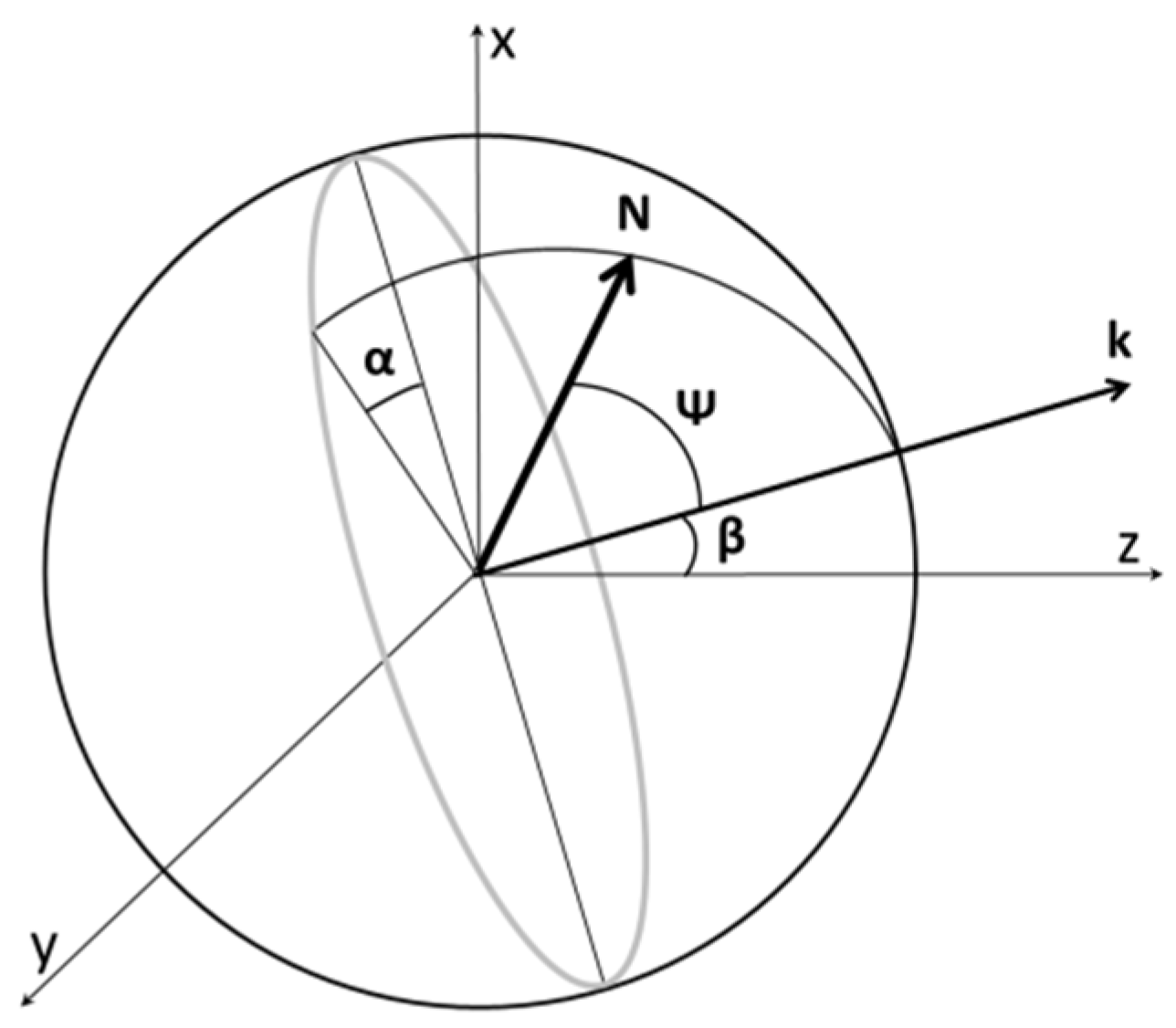

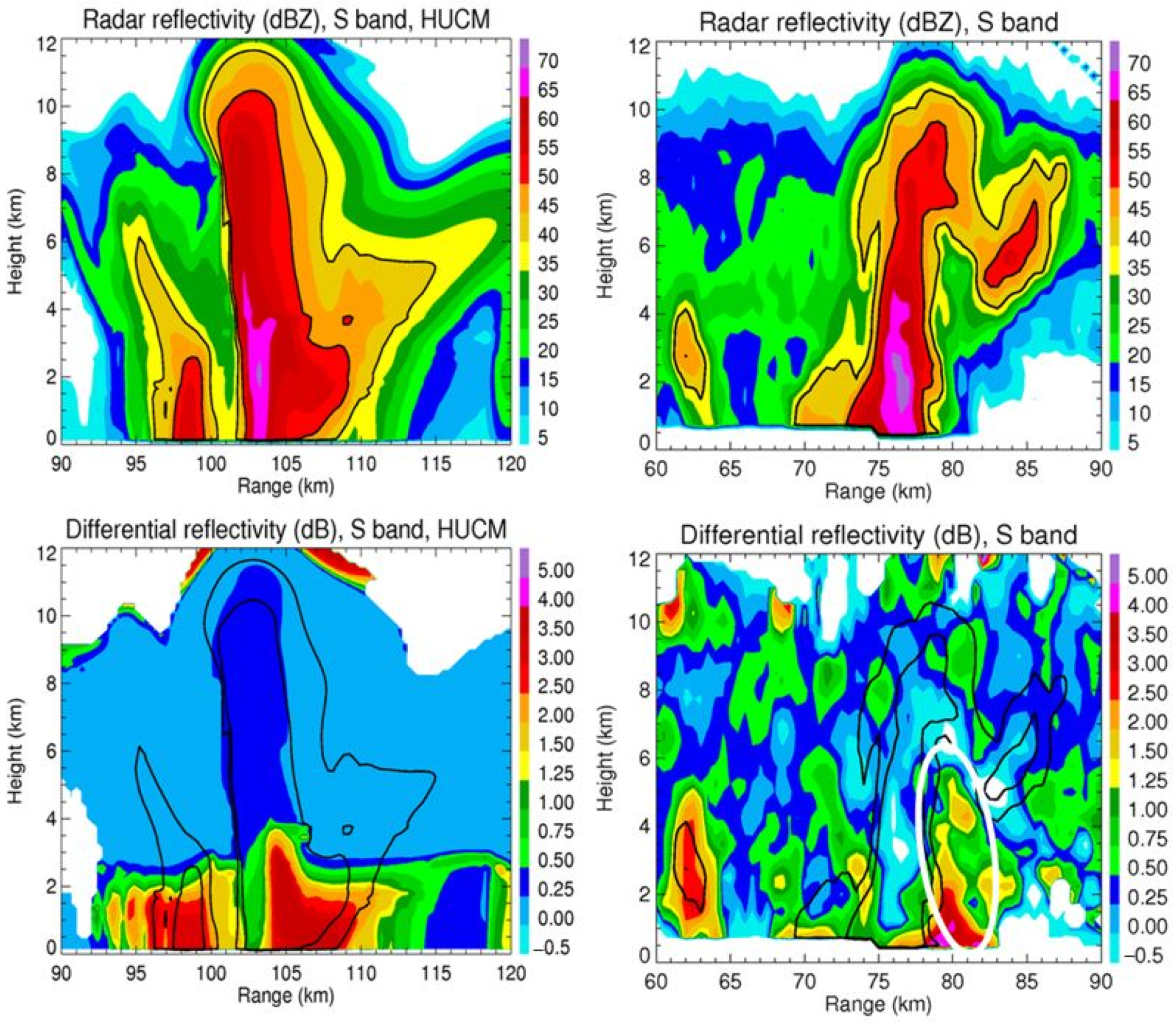
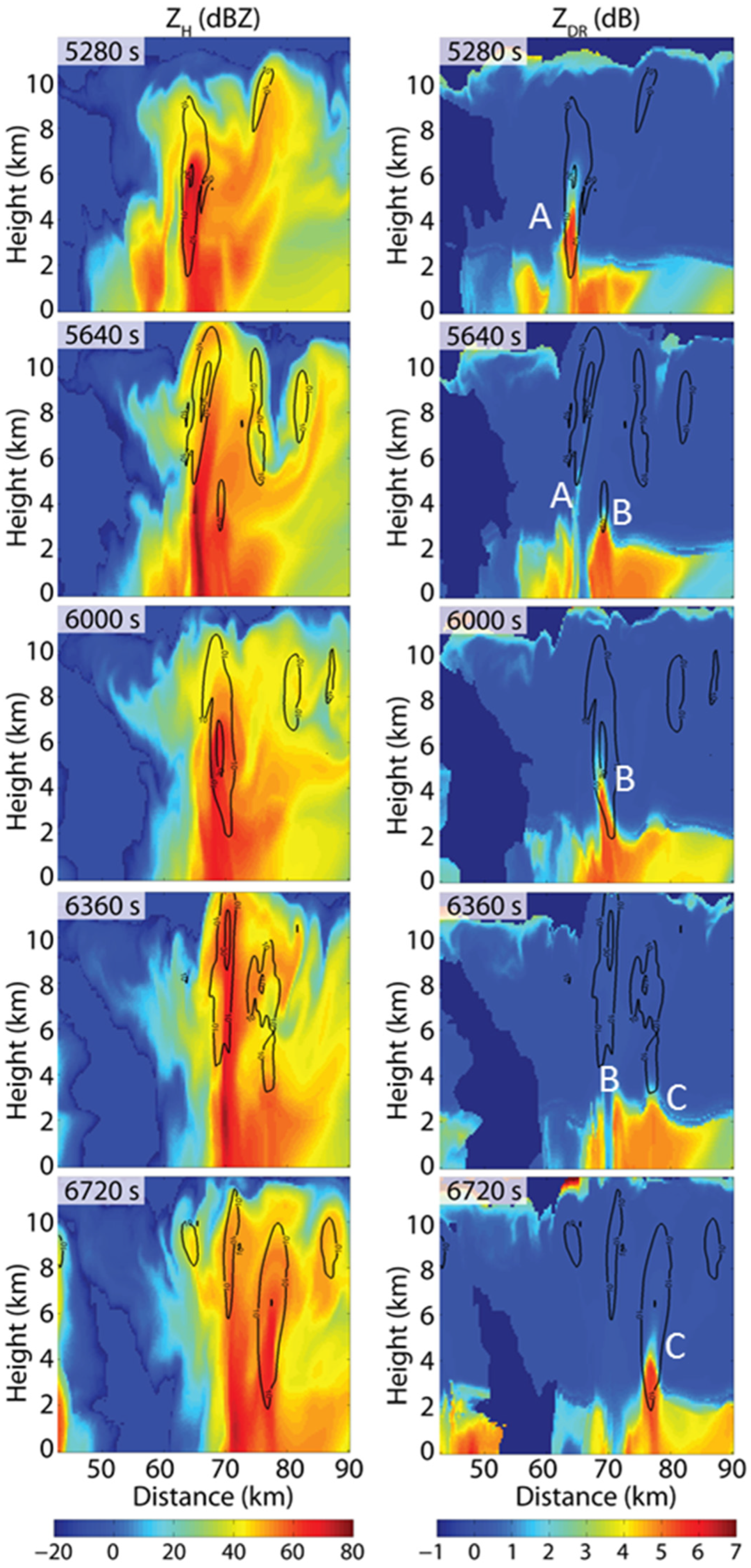



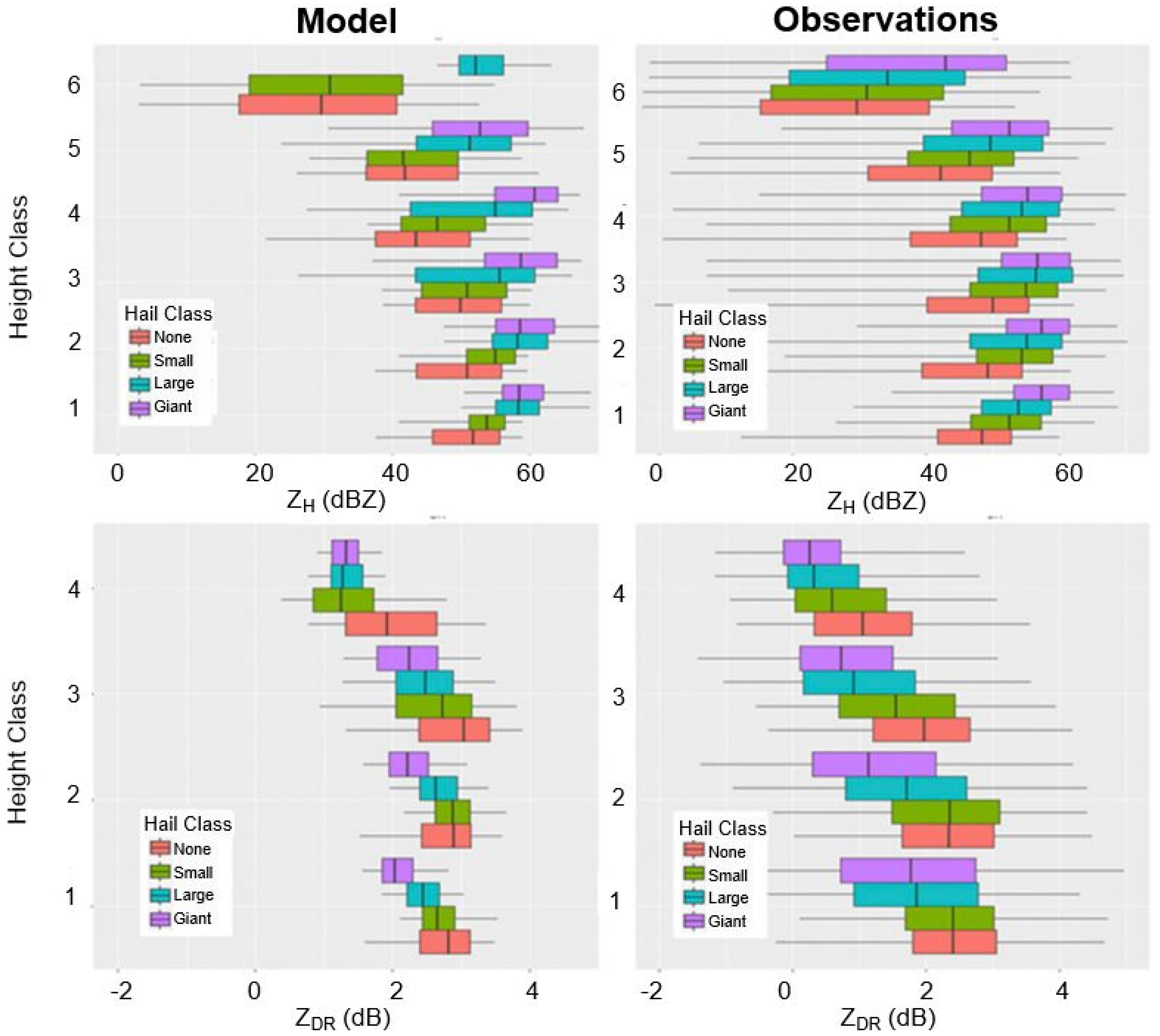



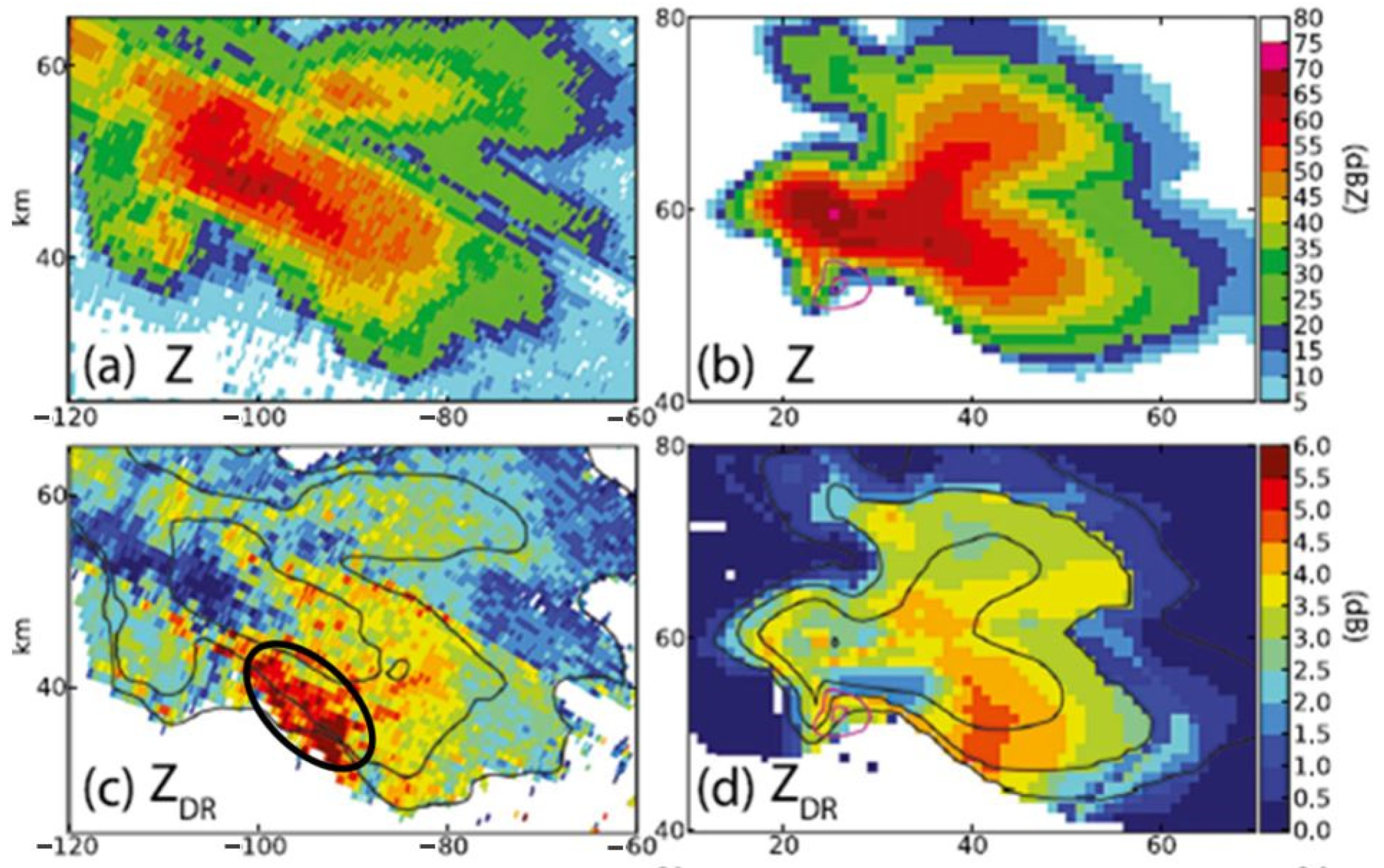


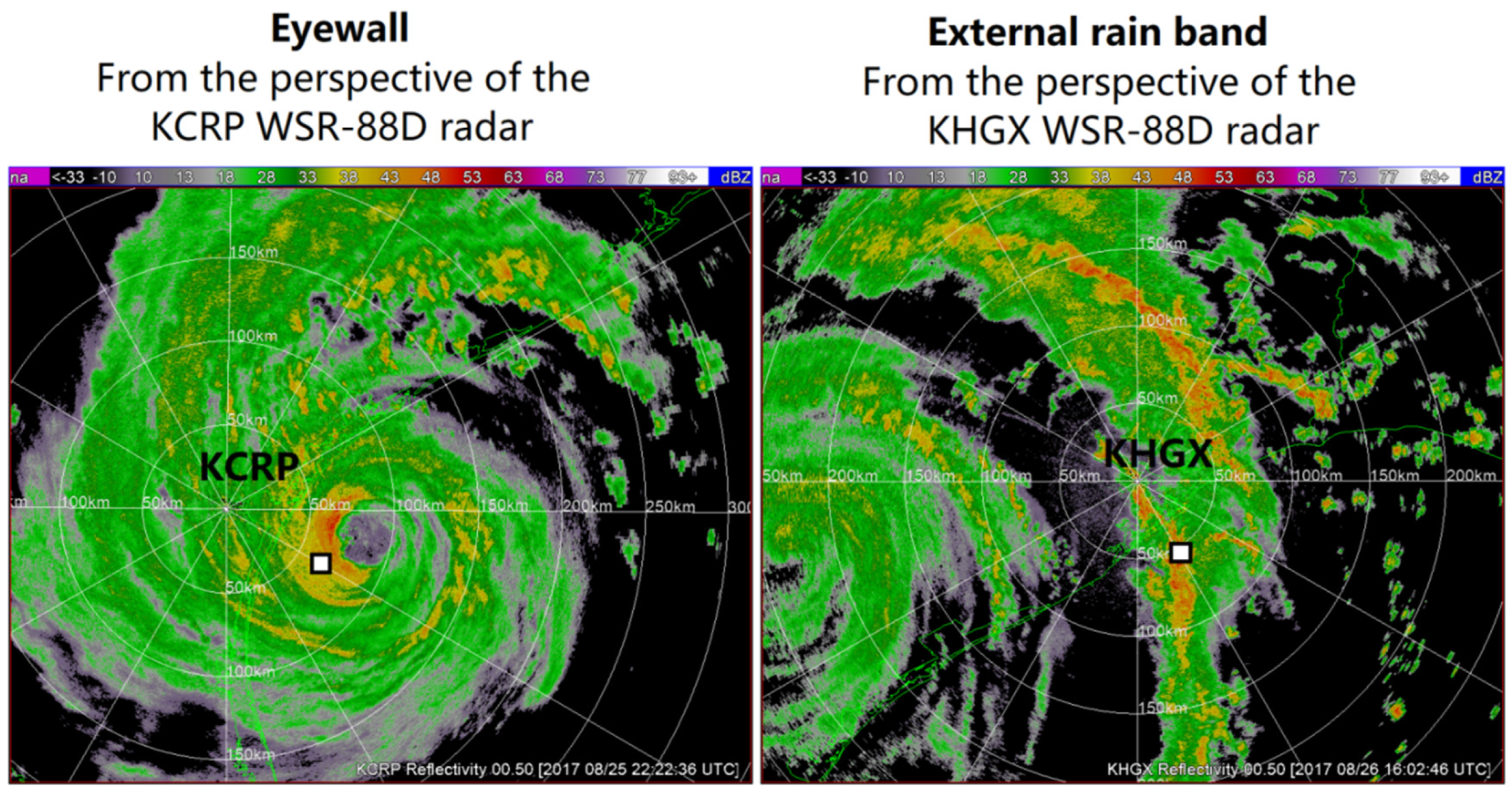




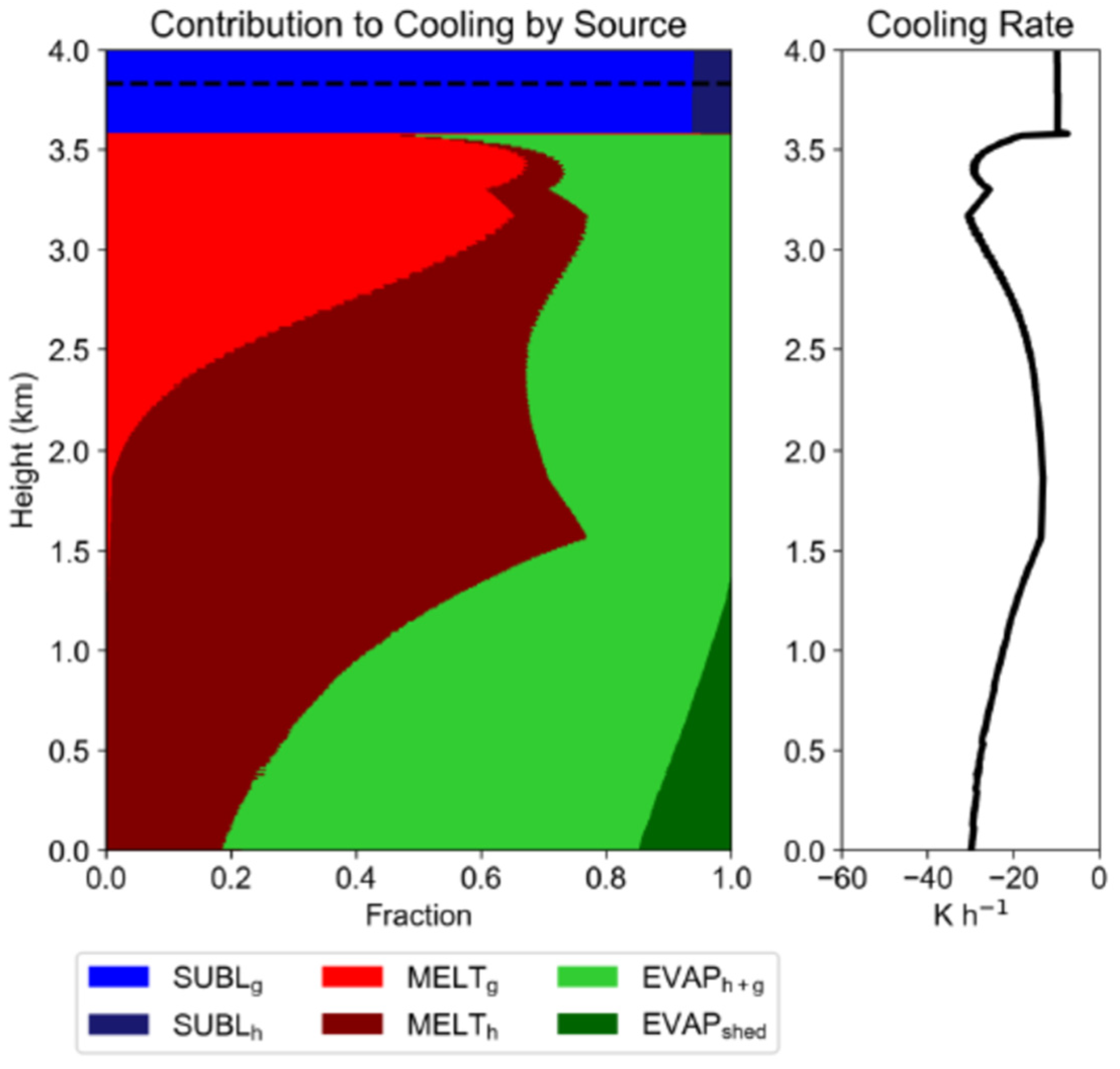
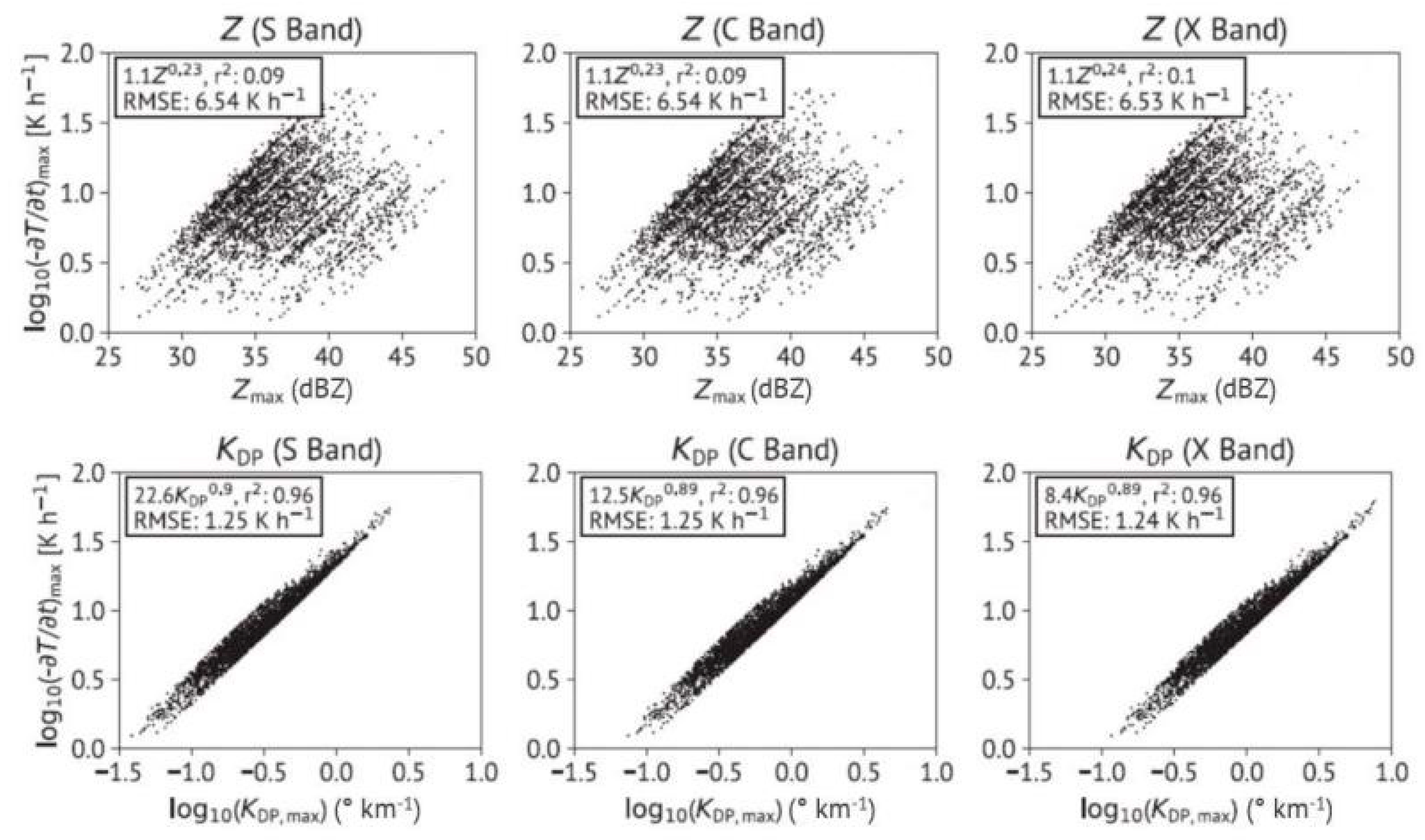
© 2020 by the authors. Licensee MDPI, Basel, Switzerland. This article is an open access article distributed under the terms and conditions of the Creative Commons Attribution (CC BY) license (http://creativecommons.org/licenses/by/4.0/).
Share and Cite
Ryzhkov, A.V.; Snyder, J.; Carlin, J.T.; Khain, A.; Pinsky, M. What Polarimetric Weather Radars Offer to Cloud Modelers: Forward Radar Operators and Microphysical/Thermodynamic Retrievals. Atmosphere 2020, 11, 362. https://doi.org/10.3390/atmos11040362
Ryzhkov AV, Snyder J, Carlin JT, Khain A, Pinsky M. What Polarimetric Weather Radars Offer to Cloud Modelers: Forward Radar Operators and Microphysical/Thermodynamic Retrievals. Atmosphere. 2020; 11(4):362. https://doi.org/10.3390/atmos11040362
Chicago/Turabian StyleRyzhkov, Alexander V., Jeffrey Snyder, Jacob T. Carlin, Alexander Khain, and Mark Pinsky. 2020. "What Polarimetric Weather Radars Offer to Cloud Modelers: Forward Radar Operators and Microphysical/Thermodynamic Retrievals" Atmosphere 11, no. 4: 362. https://doi.org/10.3390/atmos11040362
APA StyleRyzhkov, A. V., Snyder, J., Carlin, J. T., Khain, A., & Pinsky, M. (2020). What Polarimetric Weather Radars Offer to Cloud Modelers: Forward Radar Operators and Microphysical/Thermodynamic Retrievals. Atmosphere, 11(4), 362. https://doi.org/10.3390/atmos11040362



